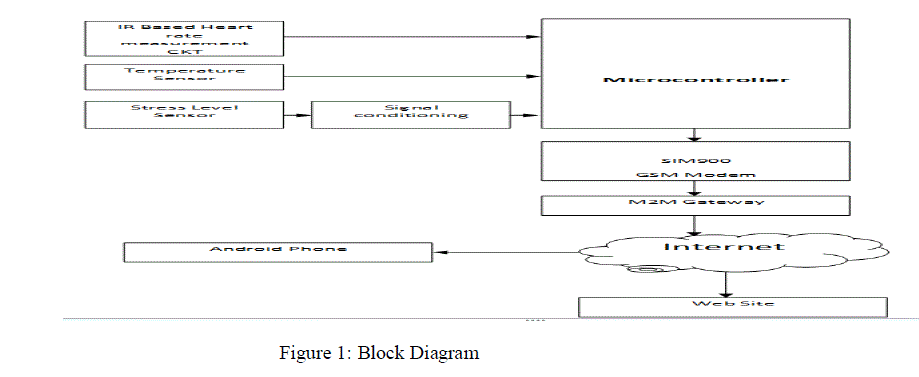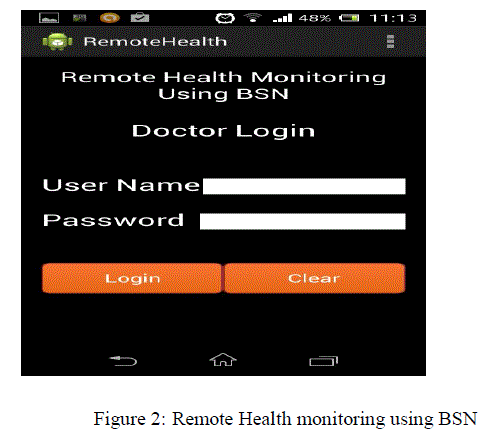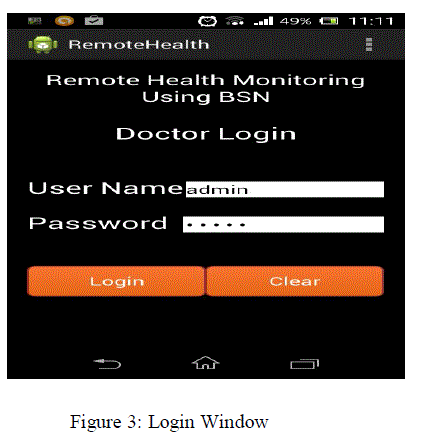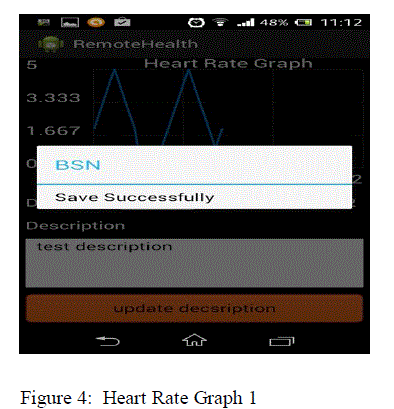ISSN ONLINE(2319-8753)PRINT(2347-6710)
ISSN ONLINE(2319-8753)PRINT(2347-6710)
R. Prakash1 and B.Paulchamy2
|
| Related article at Pubmed, Scholar Google |
Visit for more related articles at International Journal of Innovative Research in Science, Engineering and Technology
The project present a remote monitoring system for electrocardiographic and temperature signals. The system consists of a hardware module for acquisition, a Bluetooth transmission module and finally a displaying module (mobile devices). Information is sent via TCP\IP Protocol (GPRS) to a database server containing clinical data, which can be accessed through a web application. The system was assessed by testing different patients with the support of a medical doctor, obtaining a positive performance. Heart disease is increasingly affecting human lifestyle, rehabilitation and practical devices are being carried out and created in order to reduce the disability from heart diseases. This paper proposed a wireless patient monitoring system which integrates Bluetooth technology.
Keywords |
| Electrocardiogram, Phonocardiogram, Global System for Machine, Infrared. |
INTRODUCTION |
| The project represents a problem of Real Time processing of ECG signal from patients by mobile embedded monitoring stations. Two ECG measurement devices were used in real tests. A two ECG channel bipolar ECG CorBelt and a 12 channels ECG device BlueECG. Both devices are products from CorScience Company. Due to a problem of processing a 12 channels ECG from ECG device by Bluetooth to mobile stations, the problem of packet parsing was discussed and two possible solutions were focused on. Another important part in biomedical data processing is visualization. A Windows Presentation Foundation solution was presented and tested. Mobile embedded monitoring stations are based on Microsoft Windows Mobile operating system. The whole system is based on the architecture of DOTNET Framework, DOTNET Compact Framework, DOTNET Micro Framework and Microsoft SQL Server. The project was successfully tested in real environment in cryogenic room (-136°C). |
| ELECTROCARDIOGRAM (ECG) SENSOR |
| In this project, a detailed description of constructing a 2-lead electrocardiogram (ECG) sensor, transmitting the ECG data acquired from the ECG sensor via the Bluetooth wireless link, and receiving the ECG data at the PC is illustrated. The acquired ECG data is processed, manipulated and constructed as an ECG waveform. Lastly, the ECG waveform is displayed on the personal computer (PC) screen. The results show that implementation of wireless technology in the existing ECG monitoring system eliminates the physical constraints imposed by hard-wired link and allows users to conduct own check up at anytime anywhere. The newest Bluetooth communication technology was added to our previously-developed Internetbased information system, which collects short an1d long-term digitized ECGs together with relevant clinical data for the management of patients. A wireless communication protocol was developed using the Bluetooth system for short-distance (10-20 m) RF data transmission. |
| GSM UNIT |
| This unit could send compressed records to a Web server via a GSM telephone modem. During the study, 3,850 ECG-based telemedicine consultations Stook place, 1,663 ambulatory monitoring sessions with online monitoring via the Internet were performed, the thrombolysis time delay in acute myocardial was studied in 36 patients, home telecare was carried out for 39 patients with acute myocardial infarction immediately after hospital discharge, and monitoring in a nursing hospital was also used. |
| Bluetooth transmission The implemented code reads analog inputs, stored in a length of 10 bits, each of the values of the variables (ECG and temperature), before being written to the serial port, so it can be identified by weft once captured by the receiver. Defines the analog / conversion. The requirement in the step of transmitting and receiving the signal are given by the GPRS M2M protocol. |
| The received signal is then inputted into one of the following modules, either the determining heart rate module or the plotting phonocardiogram module, which both utilize a separate PIC16F877 micro controller. For the determining heart rate module, the received signal is first sent to a voltage comparator before being inputted into the PIC. |
LITERATURE REVIEW |
| As health care centers have becomes popular, daily monitoring of health-status related parameters is becoming important. An easy, comfortable and patient friendly solution for acquisition, processing and remotely transmitting the information from patient to the center is therefore an important issue. Phonocardiogram (PCG) is a physiological signal reflecting the cardiovascular status. This paper deals with a Signal Processing Module for the computer-aided analysis of the condition of heart. The module has three main blocks: Data Acquisition, Signal Processing & Remote Monitoring of heart sounds. Data acquired includes the heart sounds. The system integrates embedded internet technology and wireless technology. As the data is being sent by internet, it realizes real-time recording and monitoring of physiological parameter of patients at low cost and both at home and in hospital. The analysis can be carried out using computer initially and further by doctor. The tele-monitoring system may provide a low-cost, reliable and convenient solution for data acquisition and real time analysis of the PCG. The heart sounds are acquired using an acoustic stethoscope and then processed using software developed using the simulation tool (Python 2.7) & the recorded PCG transmitted and saved on the server. From where, any time it can be remotely accessed for expert advice and/or for further diagnosis. |
| EXTRACTION OF KNOWLEDGE FROM VARIOUS TECHNIQUES |
| Remote1 Monitoring Of Heart Sounds In Real-Time |
| As health care centers have becomes popular, daily monitoring of health-status related parameters is becoming important. An easy, comfortable and patient friendly solution for acquisition, processing and remotely transmitting the information from patient to the center is therefore an important issue. Phonocardiogram (PCG) is a physiological signal reflecting the cardiovascular status. This paper deals with a Signal Processing Module for the computer-aided analysis of the condition of heart. The module has three main blocks: Data Acquisition, Signal Processing & Remote Monitoring of heart sounds. Data acquired includes the heart sounds. The system integrates embedded internet technology and wireless technology. As the data is being send by internet, it realizes real-time recording and monitoring of physiological parameter of patients at low cost and both at home and in hospital. The analysis can be carried out using computer initially and further by doctor. The tele-monitoring system may provide a low-cost, reliable and convenient solution for data acquisition and real time analysis of the PCG. The heart sounds are acquired using an acoustic stethoscope and then processed using software developed using the simulation tool (Python 2.7) & the recorded PCG transmitted and saved on the server. From where, any time it can be remotely accessed for expert advice and/or for further diagnosis. |
| Wireless Body Area Network in a Ubiquitous Healthcare System |
| Engineers developed a ubiquitous healthcare system consisted of a physiological signal devices, a mobile system, a device provider system, a healthcare service provider system, a physician system, and a healthcare personal system. In this system, wireless body area network (WBAN) such as ZigBee is used to communicate between physiological signal devices and the mobile system. WBAN device needs a specific function for ubiquitous healthcare application. We propose a scanning algorithm, dynamic discovery and installation, reliable data transmission, device access control, and a healthcare profile for ubiquitous healthcare system. |
METHOD |
| A Monitoring system capable of reading an ECG signal and temperature signal of a patient and is then transmitted via Bluetooth to a display module that can be a personal computer (PC) or a telephony device remote is presented mobile. The captured information is sent via a GPRS network to a database implemented on a server for storage and later reference if necessary and visualization. A Web application allows access to data from any Internet-connected device. There are several errors in the capture of the ECG signal, as technical artifacts, and thus cause erroneous interpretations misdiagnosis. Mechanical or electrical artifacts caused by poor contact or movement can be simulated person arrhythmias similarly excessive movement can cause false readings as outdated appearances ST segment. |
| Non-invasive procedures for obtaining physiological signals become increasingly necessary and mark the current trend in medical |
| Practice, due to the convenience of its implementation. The problem of correct acquisition of different biomedical signals deserves special attention since this depends the success of the processes such as visualization, interpretation and remote diagnosis by the medical staff , hence inadequate filtration and pre - alignment of the signal make it very difficult finding clinically relevant information , even if the acquisition stage were backed by a robust telemedicine infrastructure, limiting the right and timely interpretation and diagnosis of patients. |
| A. System Design |
| The remote monitoring system proposed, is based on acquisition, conditioning and wireless transmission two biomedical signals to a local display system or remote, such as shown in Figure 1. |
 |
| A. Acquisition and Processing |
| Analog / Digital two signals, one of electrocardiography and over temperature are taken. For the first three lead module , which involves taking a differential signal using metal electrodes positioned at three points of the body , followed by an amplification stage and a filtering was implemented. An instrumentation amplifier was used for its high performance and recommendations in biomedical applications. Additionally, a filter stage is designed , low pass and high pass , to meet the spectral width of the ECG signal (0.05 Hz to 150 Hz ) , with the bypass type chosen. Temperature signal for the sensor LM35 was used, the resolution is given by 10mV / ° C. was calibrated for it to work in the range of average temperature as a human. The analog / digital conversion is done by ARDUINO UNO development board, which has a microcontroller (PIC Microcontroller) that makes the analog - digital conversion and serial configuration for the submission. |
| Bluetooth transmission The implemented code reads analog inputs, stored in a length of 10 bits, each of the values of the variables (ECG and temperature), before being written to the serial port, so it can be identified by weft once captured by the receiver. Defines the analog / digital conversion. The requirement in the step of transmitting and receiving the signal are given by the GPRS M2M protocol, |
| B. Receiving and Viewing |
| The signals are captured from two different devices: a mobile phone, each containing an application that enables the interpretation and visualization of signals. |
| i. Cell Phone |
| The first, corresponding to the application for the Android Operating System called ECG Monitoring and is part of: For communication transmitter equipment and mobile phone a library called ECG Monitoring, which consists of three parts was used code implemented in Android, a second, which corresponds to the Meet Android library, which is installed inside the folders of the Android and a third of which is optional, called Plug-in Bundle. Installing this application (library) is required to manage the Bluetooth connection between the devices. |
 |
RESULT & DISCUSSION |
| The work done has been the result of a compilation of different prototypes of both software and hardware for remote monitoring of bio-signals. Each of the exposed blocks has been reviewed and verified by medical staff, which corroborated the proper operation and use thereof in the field of medicine. The system has several advantages , including: portability ( small size ) , low cost, flexibility , as connectivity is concerned , expandability , as the hardware allows up to 6 analog input signals in parallel, and useful when require timely monitoring of vital signs. To verify the performance of the proposed prototype, five records (ECG and temperature) were taken for each of the 13 volunteers (5 women, 8 men - . Table 1) accompanied by medical staff, who performed and evaluated the results (Heart Rate normal and stable in all patients). |
 |
 |
CONCLUSION |
| The final concept of the system by themselves was positive and also have continuously encouraged this development is implemented in a practical way and continuity as a project. It is noteworthy that the idea of this work is to show the possibility of having a useful solution, low cost, using the existing infrastructure in telecommunications technologies at the site of interest and the use of free software tools for application development. A first approach would be the Caribbean Region of the Colombian territory. The next job is to consist pilots from different parts of the region, allowing different rural populations enjoy timely medical care and lower cost. |
References |
|